
W Korei każdy amator jakiegokolwiek jedzenia, nawet nie-koreańskiej kuchni, znajdzie coś dla siebie.
Restauracji i barów, małych i dużych, jest tutaj mnóstwo, jedna obok drugiej i codziennie można jadać w inny miejscu i napewno sie nie znudzi. Aby zjeść cokolwiek (dobrego), daleko nie musimy chodzić.
Restauracje są jedzeniowo tematyczne to znaczy jak na szyldzie widać krowę to serwuja tylko wołowinę, kurczaka - serwują tylko kurczaki, itd.
In Korea everyone can find something he likes to eat, not necessarily Korean.
There are a lot of restaurants and bars here, small and big, all next to one another and you can eat every single day in a different place so you shouldn’t get bored. We don’t have to go too far to eat something (good).
The restaurants focus here on one type of food, for example if you see a cow by the name of the restaurant, they serve only beef, if you see chicken, they serve only chicken, etc.
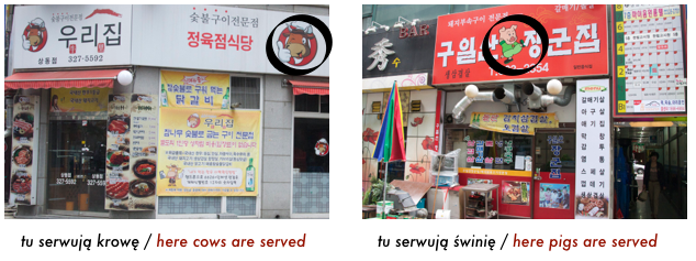
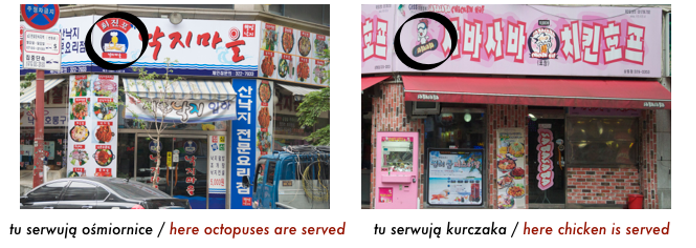
Tam gdzie na zewnątrz stoją duże akwaria z pływjącymi rybami, ośmiornicami, krabami, malżami, węgorzami i tego typu stworzeniami to tam dają właśnie można sobie takie coś zafundować. Pokazujesz palcem którą rybę/ośmiornicę chcesz, wyławiają, zabijają i zjadasz swieżutko przyrządzoną.
The restaurants where they have big water tanks outside, with fish, octopuses, crabs, mussels, eels and other similar sea food, that is where they serve this type of food, fresh, straight from the tank. Just point your finger at the fish or octopus you want to eat. Although I don’t know how they prepare and serve it.
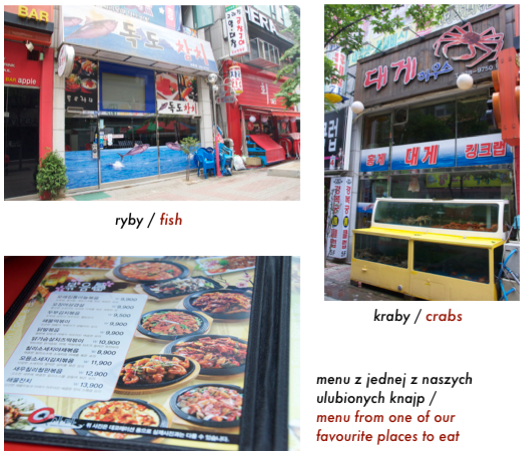
Oczywiście dane potrawy są dostępne w różnych postaciach, z różnymi dodatkami i najczęściej menu w kórym nie ma ani słowa po angielsku, są obrazki więc można pokazać palcem danie na które się ma ochotę.
Of course the meat or fish is cooked and/or served in different ways, with different sauces and/or side dishes. If you have a menu in Korean, but with pictures, then you can just point to the picture of the dish you want.
Typowo Koreańska restauracja to niski stół i siedzenie na ziemi. Tak też koreańczycy jadają w swoich domach. Używają też metalowych pałeczek. Są też miejsca gdzie są normalnej wysokości stoły z krzesłami, jak ktoś nie lubi siedzieć na ziemi.
Traditional Korean restaurant has got low tables and you sit on the floor. That is how they ear at homes. They also use metal chopsticks. There are also restaurants with normal tables and chairs, if you are not keen on sitting on the floor.

W stół wbudowany jest okrągły grill/palnik i mięso przygotowywane jest na świeżo przy tobie. Dużo jest miejsc do siedzenia na zewnątrz i stoły też mają wbudowane grille, lub w niektórych miejscach przynoszą grill przenośny i stawiają na stole.
The table has got a build-in barbecue and meat is prepared in front of you. There are a lot of tables outside as well and they also have the build-in barbecues or sometimes they bring a portable barbecue and put it on the table.

Mięso często grillują kelnerki, ale czasem dają surowe mięso i samemu można grillować. Jak jadamy wieprzowinę czy wołowinę to jeden czy dwa kawały mięsa wrzucane są na grilla, jak się zgrillują to nożyczkami rozcinane są na małe kawałeczki i potem można jeść jak kto woli - napopularniejsza opcja to zawijanie tych kawałeczków gotowego mięsa w liść sałaty, dodanie czosnku czy szczypiora czy jakiegoś sosu, zawinięcie wszystkiego razem ciasno i na raz do buzi. Bardzo smaczne.
The meat is barbecued by the waitress or sometimes they just bring raw meat and you have to do it yourself. When we eat pork or beef, one or two big pieces are thrown on a bbq. Once they are ready, you just cut them into small pieces with scissors and then you eat it straight from a bbq - the most popular way to eat it is to dip the pieces in sauce, wrap it with some spring onions and garlic in a lettuce leaf and eat it with one bite. Very tasty.
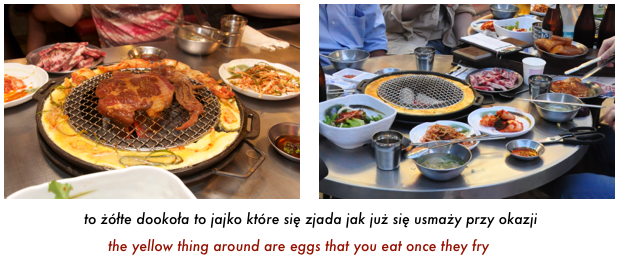

Zamawiając kurczaka dostajemy od razu gotowe danie (w stylu KFC). Przeważnie nogi czy skrzydełka, opanierowane lub nie, różnie przyprawiane.
Do zamawianych dań zawsze podawane są też sosy i przystawki. Najpopularniejsze to koreańskie ‘kimchi’ czyli warzywa - sfermentowana kapusta, rzodkiew, ogórki, cebula... Kapusta najczęściej pojawia się w sosie chilli, a inne warzywa przeważnie są podawane bez żadnego sosu. Do tego jako przystawki dochodzą jeszcze czasem zimne zupy, z kiełkami bądź innymi warzywkami, smakują trochę jak rosół a czasem jak zwykła woda z warzywami.
When we eat chicken, we usually get it ready (KFC type), legs, thighs or wings, prepared in different type of sauces.
With every main dish, we usually get sauces and side dishes. The most popular is Korean kimchi - different types of vegetables such as cabbage, radish, cucumbers, onion, but cabbage is the most common. It usually comes in a chilli sauce, and sometimes other veggies come in the chilli sauce as well, and sometimes on their own. Sometimes we get different types of soups, mainly cold with sprouts, or other veggies, some sort of broth but most of the time they taste like water with veggies.
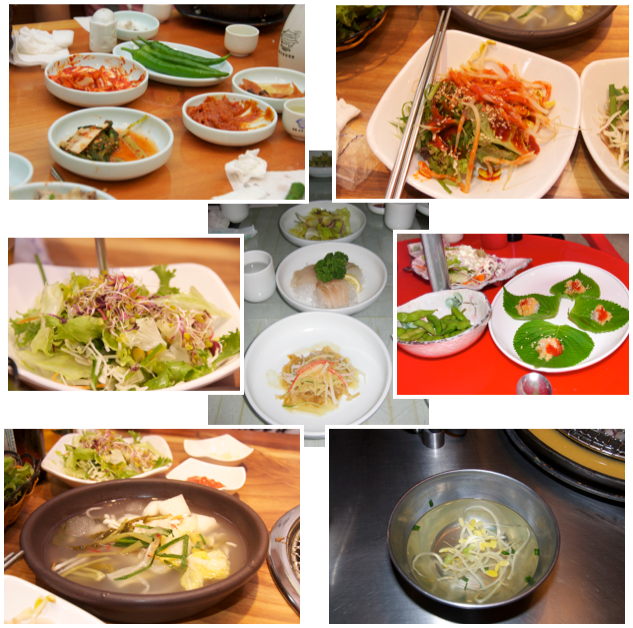
Kto nie przepada za pikantnymi daniami, czy koreańską kuchnią i nie lubi eksperymentować np z ośmiornicami, zawsze może iśc do lokanych ‘macdonaldów’ typu Lotteria czy Popeye, i wszystkim znane McDonalds, KFC, Burger King, Pizza Hut.
Są tutaj też Hinduskie restauracje w których można zjeść dobre curry, czasem odwiedzamy Australijską “Outbacks” wktórej dają dobre steki i rybę (filet); Bennigan’s to też zachodnia knajpa w której serwują steki czy kurczaki z frytkami (nie tak smacznie jak w Outbacks). Jest tu też spory wybów knajp chińskich czy japońskich.
If you are not that keen on spicy Korean food and you don’t really like experimenting with food, you can always go to local fast food restaurants such as Lotteria or Popeye, and of course McDonalds, KFC, BurgerKing, or Pizza Hut.
There are also a few Indian restaurants where you can have a really nice curry. Sometimes we go to Australian “Outbacks” where they serve really nice steaks and fish. Bennigan’s serves western type of food such as steaks and chicken with chips (not so good as Outbacks’). There is also a big choice of Japanese or Chinese restaurants.
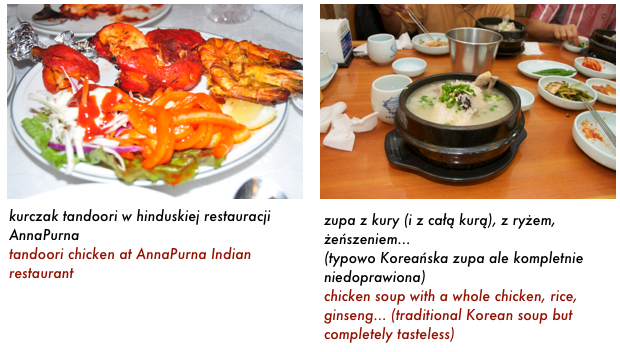
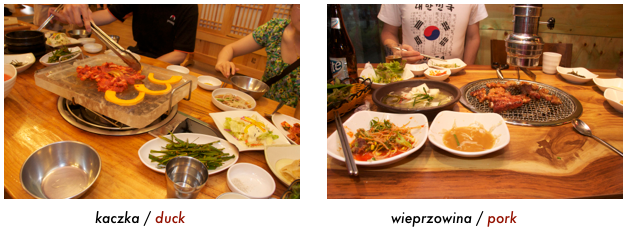
Dijon Euro Family Restaurant to jedno z moich ulubionych miejsc. Płaci się za osobę stałą kwotę (wieczorem to 18,900 WON - około 50 PLN), i można jeść i pić do woli. Dania są wystawione na zasadzie bufetu więc można ładować na talerz ile się zmieści bądź wracać po kilka razy, a dania są różne od spagetti, po sałatki, sushi, Koreańskie dania, kurczaki, rybę, warzywa, ryż, itp. Dania są podpisane niestety tylko po koreańsku (nijak się to przekłada na nazwę restauracji) więc jedynie po wyglądzie można się domyślić co to za danie. Mnie się bardzo podoba wystrój - na 8 piętrze, wewnątrz budynku ale ma się wrażenie jakby się było na zewnątrz, troche w klimacie francuskim.
Dijon Euro Family Restaurant is one if my favourite places. You pay per head (in the evening it’s 18,900 WON - about £11) and you can eat and drink as much as you want. It’s a buffet dining so just load your plate and eat :) You can try spaghettis, salads, sushi, Korean dishes, chicken, beef, fish, vegetables, rice, noodles, etc. The names of all dishes are all in Korean (you would expect some English looking at the name of the place) so only looking at the food, you can figure it out what it is. I really like the decor of the restaurant - it is on the 8th floor inside the building, but it feels as if you were outside, a little bit French in style.
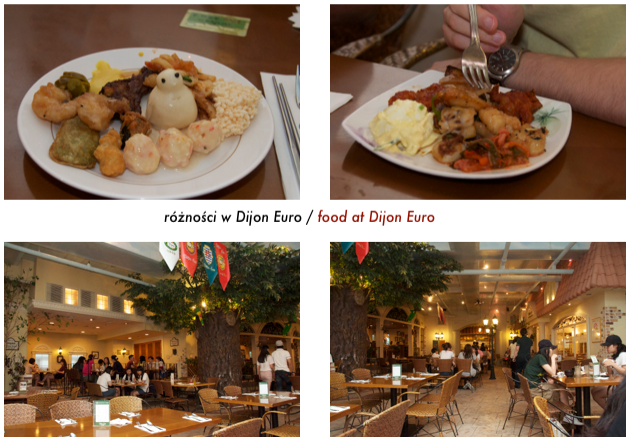
Do zamawianych dań zawsze podawana jest woda; Piotrek prawie zawsze zamawia Koreańskie piwo Hite lub jeśli ma z kim się napić - koreańską ‘wódkę’ Soju.
Cenowo jadanie w knajpach jest bardzo tanie. Podobno tańsze nawet niż kupowanie produktów w sklepie i przygotowywanie samemu w domu. Za 2 osoby w ‘wieprzowej’ restauracji zapłaciliśmy w zeszły weekend 30,000 WON co daje okolo 78 PLN. Trochę za dużo zamówiliśmy więc spokojnie 3 osoby by się najadły. Za 5 osobową kolację w inny dzień zaplaciliśmy 65,000 WON (około 170 PLN). Wszystko zależy od tego co się jada. Kurczaki, wieprzowina i morskie stworzenia są najtańsze. Wołowina jest tutaj bardzo droga - za 3 osoby ktoregoś dnia zapłaciliśmy 93,000 WON (około 240 PLN)
Water is always served with every meal, in every restaurant. Piotr usually orders Korean beer Hite, or if he has a company to have a drink with, then he orders Korean ‘vodka’ - Soju.
Prices of dining out here are really low. Apparently it is even cheaper to dine out than buy all products and cook at home. For 2 people in a ‘pork’ restaurant we paid last weekend 30,000 WON which is around £17. We ordered a little bit too much so it would be enough for 3 persons. On a different occasion for 5 people we paid 65,000 WON (around £40) . It all depends what you eat and where. Chicken, pork and sea food are the cheapest. Beef is really expensive - the other day for 3 persons we paid 93,000 WON (around £60).
Koreańska kuchnia ogólnie jest raczej pikantna i może nie wszystkim pasować; dużo kapusty, sałaty, rzodkwi, chilli, papryki, cebula, czosnek, zupy, nudle (makaron), ryż a wszystko jako dodatki do mięs czy ryb.
Korean cuisine is rather spicy so not to everyone’s taste. They eat a lot of cabbage, lettuce, radish, chilli, peppers, garlic, onions, noodles, rice and it is all served with meat or seafood.
Zapraszam do obejrzenia filmu: / Watch a video about Korean Dining:
O deserach i przekąskach innym razem :)
Desserts and snacks - another time :)
